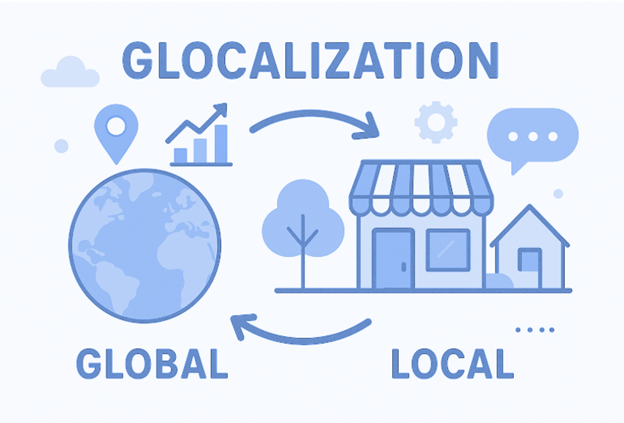Crafting an Effective Global Marketing Strategy with ConveyThis
Crafting a Successful Global Marketing Strategy
In our modern digital world, geographic boundaries pose far less barrier to business expansion than ever before. Thanks to globalization and more open trade policies, taking products and services to international audiences is more feasible than ever. However, effectively engaging overseas customers requires careful crafting of localized marketing strategies tailored for each market.
This in-depth guide explores how to build adaptable global marketing plans while providing real-world examples of brands that got it right. Read on for a comprehensive look at what it takes to successfully charm customers globally.

Defining Global Marketing Strategies
A global marketing strategy aligns a brand’s overarching identity and vision with targeted promotional strategies customized for specific international regions. The goal is presenting a consistent brand ethos across all markets while localizing messaging, offerings and experiences to resonate with regional cultural values and preferences.
Common global marketing frameworks include:
- International – Uniform marketing approach worldwide without localization
- Multi-Domestic – Heavy focus on tailoring tactics for each local market
- Global – Emphasis on cost efficiencies and standardization over localization
- Transnational – Balancing localization with global consistency
Regardless of strategic approach, research-driven adaptation focused on cultural nuances, customer insights, and local best practices is key for global marketing success.
The Far-Reaching Benefits of Global Marketing
Developing capabilities to market globally delivers significant advantages:
- Expanded brand awareness and reach by tapping into new overseas locales
- Lowered advertising costs through consolidation of universal brand assets and centralized buying power
- Enhanced product quality and appeal through localized improvements tailored to each market
- Competitive edge from leveraging multinational experience and integrating global insights
With a well-crafted global strategy, marketing’s role evolves from a cost center to a profit engine driving incremental international revenue and share.


Prerequisites for Building an Effective Global Marketing Plan
Launching successful marketing worldwide requires upfront groundwork:
Thorough market research – Analyze consumer attitudes, behaviors, frustrations, and preferences in each target locale. Avoid generalization. Distinct customer insights are key.
Understanding pain points – Identify market-specific pain points and needs through surveys, interviews, and data analysis. Localization should address these appropriately.
Multi-regional planning – Develop integrated strategies and campaigns that balance consistency across markets with tailored regional adaptation based on learnings.
Localization – Tailor messaging, creative assets, channels, partnerships and more to align with cultural values and resonate in each local context. But avoid change solely for change’s sake.
Meticulous preparation provides the insights to guide strategy and tactical activation. With this foundation, the global marketing plan can take shape.
Bringing the Global Marketing Plan to Life
With essential groundwork completed, how does a world-ready marketing blueprint come together in practice? Though specific approaches will vary, effective global plans often exhibit these core elements:
- A unified brand vision and positioning globally, aligned with company values
- Centralized development of core assets like logos, slogans, and visual identity
- Shared global initiatives on digital platforms and social media channels
- Economies of scale through global agency relationships and buying power
- Regional personalization of messaging themes based on cultural insights
- Tailored digital experiences, promotions and partnerships fitting local flavor
- Adaptation of physical materials, packaging and displays to fit regional aesthetic norms
- Nuanced translation and transcreation for maximal localization resonance
- Balanced use of global and local brand ambassadors and influencers
- Integrated in-region teams for insights on ongoing localization opportunities
The ultimate formula harmoniously blends standardization with customized regional activation – think globally, act locally.

Navigating the Obstacles of Global Marketing
While delivering significant upside, global marketing also comes with challenges to thoughtfully navigate:
Adapting to diverse audiences – Localizing campaigns to align with varied cultural norms while maintaining brand integrity is an art and science. Avoid a one-size-fits-all mindset.
Navigating regulations – Adhere to laws, privacy regulations, and ethical norms in every target country. GDPR, human rights, etc. Compliance enables success.
Translating flawlessly – Precise localization of language, terminology and messaging is indispensable for engagement and conversion. Avoid embarrassing mistranslations.
Coordinating processes – With numerous target markets, streamlining workflows across regions, agencies and internal teams is imperative for managing complexity.
Monitoring ROI – Put disciplined analytics in place from the outset to measure marketing effectiveness and guide strategy in each major locale.
With careful orchestration, these hurdles are surmountable. The upside makes overcoming them worthwhile.
Notable Examples of Global Marketing Done Right
Looking at brands excelling at worldwide promotion provides models for success:
Domino’s Pizza – Offers localized toppings by market while keeping core menu consistent. Reinforces flexible localization.
McDonald’s – Known for market-exclusive menu items paired with standardized branding. Balances approaches.
Nike – Develops globally integrated branding campaigns brought to life through local influencer partnerships. Thrives on coordinated personalization.
Coca-Cola – Blends universally iconic assets like Santa ads with celebrations of local culture in regional activations. Universal yet local.
These leading practitioners provide inspiration for marketers navigating the globally-local balance.


The Critical Role of Multilingual Digital Experiences
While print, outdoor, TV, and experiential remain important, digital channels now sit at the epicenter of most global marketing efforts thanks to their reach, targeting, and measurability.
In digital, tailored multilingual experiences are the key to customer engagement. Marketing localized across cultures is ineffective when websites remain English-centric.
Thankfully, modern translation solutions like ConveyThis allow adapting sites for global audiences with ease. Blending AI and human linguists, they render every page into localized text, images, video and more at scale. This streamlines exploring new frontiers.
Expert Tips for Global Marketing Success
Based on proven results, here are recommendations for maximizing marketing impact across borders:
- Immerse in local cultures and customers before activating in new regions. Avoid assumptions.
- Consult local partners on the ground for adapting initiatives and assets to their market.
- Ensure brand identity elements like logos transcend cultural contexts through universal design.
- Before full localization investment, test demand with English-language digital campaigns.
- Measure online behavior and analytics continuously to identify growth opportunities worldwide.
With the right localized mindset, any brand can transition from domestic player to global powerhouse.
The Evolving Future of Global Marketing
While global marketing shows no signs of decreasing in importance, its shape will continue evolving in the decade ahead:
- Transcreation will ascend as localization and translation get ever more sophisticated.
- Personalization and adaptation will increasingly happen programmatically through cross-regional customer data and intelligence.
- Digital experiences will become the primary brand touchpoint as ecommerce and internet penetration grows globally.
- Mobile-first approaches will dominate, as smartphones remain the primary digital device across most emerging markets.
- Regional partner networks will decentralize activation hubs as remote collaboration technology improves.
- Attribution modeling and multi-touch analytics will connect global efforts to local sales impact better.
Savvy marketers will integrate these trends into their strategies and processes to sustain a competitive advantage worldwide.
The Mandate for Marketing Globally
For businesses of all sizes across industries, developing integrated global marketing capabilities is no longer optional – it’s an imperative for growth. The world continues globalizing, and customers everywhere demand tailored local experiences.
With the strategies, insights and solutions outlined in this guide, brands can rise to meet this mandate. While global marketing brings complexity, done effectively, it generates outsized rewards by opening up unprecedented horizons. The time is now for marketers to think bigger by activating locally worldwide.
Let me know if you need any clarification or have additional questions based on this comprehensive overview of successfully marketing globally in today’s interconnected world. I’m happy to provide any other details that would be helpful.

Translation, far more than just knowing languages, is a complex process.
By following our tips and using ConveyThis , your translated pages will resonate with your audience, feeling native to the target language.
While it demands effort, the result is rewarding. If you’re translating a website, ConveyThis can save you hours with automated machine translation.
Try ConveyThis free for 3 days!
 No card details
No card details



